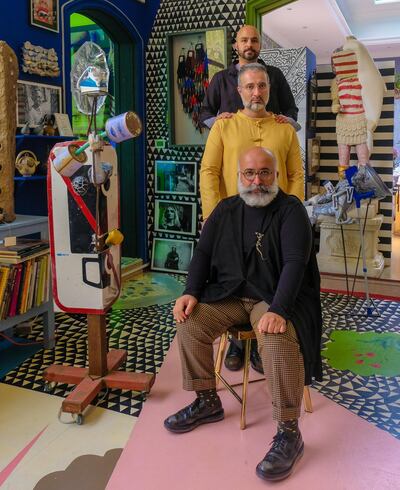For the past month, nearly every day at lunchtime, three artists in Dubai have filmed a table at their house, starting at one end and moving slowly down its length from an overhead perspective.
The table as a site of eating, work and socialisation is the quarantine experience for many.
It is this, life pulled inside, that is investigated aesthetically in the new work by artists Ramin and Rokni Haerizadeh and Hesam Rahmanian. The six-and-a-half-minute record of their life over the past month, From March to April... 2020 responds to the coronavirus crisis.
The table's crowded surface offers clues to their morning activities: computer cables; containers of paint; drawings and print-outs; and copies of The National (they are subscribers) with its glimpses into the world outside their home.
Dishes of food, prepared by Ramin, the quiet, gnomic one of the trio, are nestled between the objects.
You can see the work here:
Since they moved to Dubai 11 years ago, the two brothers, Ramin and Rokni, and their childhood friend, Rahmanian, have been living and working together in their studio/home in Al Barsha.
They have separate practices, but are known best for the work they make together: surrealist collages made of newspaper imagery, which they paint onto with muted colours. Anthropomorphic assemblages and patterned design objects, and “moving paintings” or animations of their doctored images.
“Call us a creature with six eyes,” says Rahmanian. “One person does one thing, while another comments with a totally different angle. Then we take that seriously, and negotiate.”
“Since the lockdown we have lived at our table,” says Rokni. “Sometimes you do not know whether you are eating food or colours.”
Each view over the table is about 30 seconds: they edited the takes together so the scenes fade into one other. As the soundtrack they chant the days of the week, speaking in one tone: "Wednesday, Thursday, Friday, Saturday …"
The domestic scene is briefly interspersed with intertitles from Mahmoud Darwish's poetry and references to the landmark Iranian documentary The House Is Black. The effect is one of monotony and also of things going too quickly – scenes passing by before you can finish taking them in.
Time is a frequent subject in their work, says Rokni, the younger of the two Haerizadeh brothers and the de facto spokesman for the group. “We are always talking about the non-linearity of time. That there is a difference between time and duration.” Time, he says, is an “effect of the imagination” – different to the dailiness of life, which the artists signal through their use of the newspapers, which appear like clockwork on their doorstep.
The idea of turning their life into art, to put it broadly, is also an idea that floats around their practice. Last year, for example, they turned their Gallery Isabelle van den Eynde in Dubai into their studio for seven months, allowing the public to watch them in the creative process.
And From March to April picks up on the collages they have made over the past three years, where they take photos of what they call their "morning landscape" of coffee cups, pages from The National, and odds and ends like food and flowers on the table. They then add to the images, drawing animal-like features on figures from the paper or bands of stripes and swirls. Each image is successively retouched and and re-photographed until the final work is a document of many moments.
But the three are quick to dismiss the idea of their work as purely reflecting themselves or their working method; one has the sense that they have answered questions about their unique set-up one too many times before.
"The idea of authorship is Western," says Rokni, pointedly. In their works, it is as if authorship is dispersed not only among the trio, but in the objects themselves.
The inspiration for the video came while the three were in an airplane en route to Sydney to participate in the city’s biennial in March. They were passing what they call “frames” to each other, or some of the thousands of A4-sized print outs from YouTube clips that they assemble into their moving paintings.
They started thinking about contamination, as the frames moved from one person to the next, taking on each other's ideas and achieving a life of their own. The experience of the plane also found its way into the final product. The camera's perspective, looking downward at the table, mimics the plane's vantage point.
The idea of a "third path" is a recurring theme in the video, taken from Darwish's poem Wednesday, Friday, Saturday. "If I had two paths," he wrote, "I would choose the third."
Perhaps the ultimate lesson of lockdown days is not monotony nor restriction, but the opportunity to make something new.







